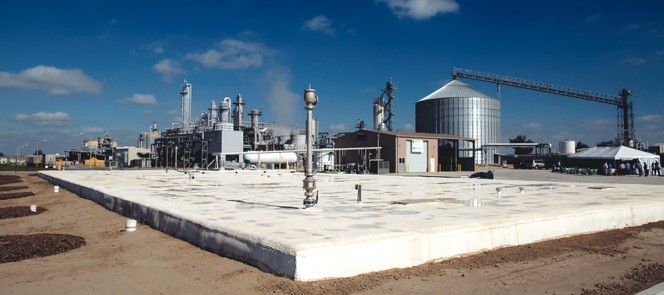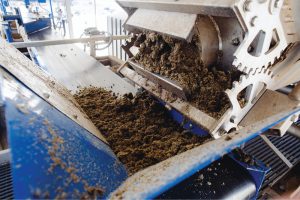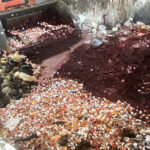Pixley Biogas in Pixley, California is the state’s first anaerobic digester that is powering another renewable energy facility.
Dan Emerson
BioCycle June 2015

A DVO mixed plug flow digester (foreground) was installed at the Calgen Renewable Fuels ethanol plant (background) to process dairy manure from a nearby farm with about 10,000 gallons/day of food waste. Photos courtesy of Regenis
The new Pixley Biogas anaerobic digestion (AD) facility in Pixley, California is the first AD plant in the state to power another renewable energy facility. Built adjacent to the Calgren Renewable Fuels ethanol plant, the Pixley Biogas digester processes solid and liquid manure from Four J Farm Dairy, a nearby dairy farm with about 2,000 head of cattle, along with some food waste. Calgren produces about 55 million gallons of ethanol annually. The biogas replaces about 5 percent of the natural gas used to produce the hot water needed for ethanol production, according to Daryl Maas, CEO of Redding, California-based Maas Energy Works, Inc., which serves as a consultant to Calgren. The eventual goal is a mix of 10 percent biogas and 90 percent natural gas mix, which would yield about $50,000 a month in savings.
Pixley Biogas is owned by Pixley Cogen Partners, LLC, an affiliate of Calgren. Designed by DVO, Inc. of Wisconsin and built by Regenis of Ferndale, Washington, the DVO Two-Stage, Mixed Plug Flow™ digester receives 55,000 gallons of solid and liquid manure daily from the farm, and about 10,000 gallons/day of food waste. The manure is pumped through a one-mile-long, PVC pipe that is 8 inches in diameter. Four J Farm Dairy and Pixley Biogas essentially have a barter arrangement, where Four J supplies the manure and in return, it receives digested solids to use as bedding for its dairy cows and effluent to apply as fertilizer on its fields. Food waste is trucked in by several area food processors, renderers and grease-trap pumping services. The digester tank can hold approximately 1.2 million gallons of manure and food waste.

Separated digested solids are used for cow bedding; effluent is land applied by the dairy farm as fertilizer.
Fast track-construction of the $10 million system began in February 2014, and within six months the digester began operations, Maas says. Two full-time employees operate the digester. Holding time in the digester tank is about three weeks (at 100°F). Solids content of the raw manure is about 2 to 3 percent; the plant can handle food waste with up to 20 percent total solids. “It works really well because the microorganisms love the sugar, fat and proteins in the food waste,” notes Maas.
Biogas production is around 350 cubic feet/minute. A unique feature of Pixley Biogas is that waste heat from the ethanol plant is used to both heat the digester, and pasteurize (at 135°F) the digested liquid manure that is used for fertilizer. The facility receives carbon credits for its greenhouse gas emissions reductions.
Siting And Financing
The most challenging part of the Pixley project was navigating the lengthy state environmental review process, Maas notes. “Getting the permit was moderately difficult, but getting everyone to sign-off through the process — including neighbors and community groups — was very complicated.” It initially takes time for some area residents and groups to accept the manure plant concept, “but it was fully approved, gained public support, and we’ve had no complaints. It just took a long time,” he adds.
To help finance installation of the facility and its mile-long pipeline connecting the dairy manure supply to the digester, the project received $4.6 million in grant funding from the California Energy Commission (CEC). Adding the pipeline was “quite expensive, but, compared to trucking the manure, this is a much better way to run,” Maas explains. “We not only save on operating costs and complexity, but this way the farm can pump manure whenever it wants.”
The digester also helps reduce emissions in the San Joaquin Valley, which has “some of country’s worst air pollution,” noted Janea Scott, a CEC commissioner at the Pixley plant’s ribbon cutting.
According to the American Biogas Council, replacing just 10 percent of California’s natural gas supply with renewable gas would reduce greenhouse gas emissions by tens of millions of metric tons per year, while cutting wildfire, air pollution and landfilling.
Lyle Schlyer, president of Calgren Renewable Fuels and Pixley Biogas, Inc., notes that adding the biogas capability at the ethanol plant “lowers our carbon intensity and does a lot of good things, environmentally.” Calgren, which operates one other ethanol plant in Kansas, doesn’t have any specific plans for more biogas plants, but “we’re always on the lookout for projects that are a good fit.”
Dan Emerson is a Contributing Editor to BioCycle.












